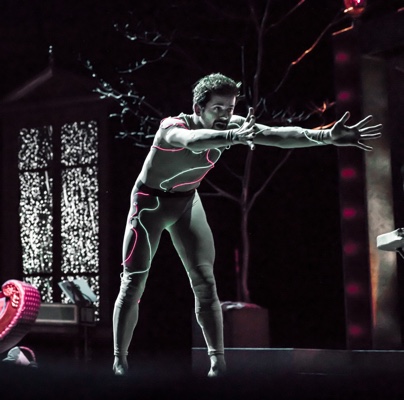Frankenstein Is Back Again, but This Monster Won’t Scare Anybody

Robert Fairchild in a scene from the Off-Broadway premiere of Mary Shelley’s Frankenstein - Photo credit: Shirin Tinati
In the summer of 1816, poet Percy Bysshe Shelley, his wife Mary and poet Lord Byron vacationed together at Lake Geneva, Switzerland. One night the three pledged to write a horror story to kill time because it rained every day and there was little to do. Shelly and Byron did minimal work, but Marry Shelley plunged into a story about a doctor who sews part of different corpses together into a man, gives him life and then deals with the monster he has created, rather badly. The doctor was called Victor Frankenstein.
I take it you’ve heard of Frankenstein? Everybody has. The reading public of 1818, when the book was published, did not know what to make of the odd story, but, later, Hollywood certainly did. Producers and writers there embraced Frankenstein’s monster and he prowled film screens for a hundred years, terrifying several generations of Americans. Shelley’s original story was changed here and there, characters added, villagers with torches chasing the eerie monster thrown in and a lot of spooky scenes and syrupy, scary music inserted into the story. Frankenstein was a big movie hit and both the doctor and his monster became household names the world over.
How big was the monster? Frankenstein and his creature have appeared in more than 70 movies over the years and they are shown on television endlessly. They include Frankenstein, The Bride of Frankenstein. The Son of Frankenstein, The Ghost of Frankenstein, Frankenstein Meets the Wolfman, and even Abbott and Costello Meet Frankenstein. The monster has been portrayed, with significant scariness, by Bela Lugosi, Boris Karloff and Lon Chaney Jr., among others.
Now we have the dreary Mary Shelley’s Frankenstein, adapted into a play, with music, by Eve Wolf, that opened last week at the Pershing Square Signature Theater Complex on W. 42d Street, New York. We all know Frankenstein. He is ugly, real tall, favors rugged boots and walks around with his arms outstretched, big metal bolts coming out of his neck, wears clothes that do not fit him, and has lots of stitches. Playwright Eve Wolf’s Frankenstein at Pershing Square is really different. Played by Broadway star Robert Fairchild (An American in Paris), he is part monster, part ballet dancer and all gorgeous. He does not try to frighten anyone. Fairchild dances, tumbles and catapults about the stage just about all night long from one frenzied moment to the next. Your head spins following his antics. He is theaterdom’s energizer bunny.
The basic story in this new version of the play is similar to the traditional Frankenstein tale, but with a lot of changes, and I mean a lot. There is an opera singer, Krysty Swann, who ambles on to the stage from time to time and sings tunes by J.S. Bach and Franz Schubert (there is music by Franz Liszt, also). There does not appear to be any reason for the music in the play, or for her, either. There are enormous photos of Frankenstein’s monster shown on the stage (he looks like he leaped off the cover of GQ magazine) and big weather photos (it is always raining and loud thunderclaps fill the theater). There are pianists left and right playing a musical score of some kind by Bach, Liszt and Schubert. Why? Mary Shelley, the main character in the play, delivers dialogue from her book but then pulls out her trove of letters and reads some of them. She reads her father’s letters. She reads anybody’s letters. Bring letters to the play; she’ll read yours, too. There is a child who is murdered by the monster and gets dragged around a bit, but then nothing happens (ever wonder why children are always dragged around in monster movies and plays?). Wolf’s tale is vastly different than the movie Mary Shelley’s Frankenstein, too, hailed when it opened in 1994 as being true to the novel.
I just did not know what to make of the play, that sprawls across the stage in a dozen bizarre directions. Eve Wolf, in a program note, also says this is a woman’s view of Frankenstein. It is? To me, a monster is a monster, right? Men and women do the same thing when they see monsters; they run.
The play goes on and on and on. Mary reads letters and argues with her husband and the monster pops up here and there, tumbling away. Music blares. I just don’t know what to do. Fairchild’s frantic monster is no match for the great movie monsters. The story goes nowhere. You never have a sense of fright. This is a horror story with no horror. The only real excitement is when Percy Shelley drowns.
The actors in the play do fine work. Mia Vallet is good as Mary Shelley, writing away in her notebook as the action swirls around her. Paul Wesley is good doubling up as Percy Shelley and Victor Frankenstein. Rocco Sisto is fine as Shelley’s dad, and Shiv Ajay, Peyton Lusk and Avey Noble are fine as the three kids in the play. The musicians, Kemp Jernigan, Steven Lin and Parker Ramsay, play their classic tunes well. Fairchild, as the monster, is well, bounding about. Director Donald T. Sanders does good work with a wild, disorganized and ineffective script.
This Frankenstein and his monster need more electric bolts shot into them and way better stitching.
PRODUCTION: The play is produced by the Ensemble for the Romantic Century. Sets: Vanessa James, Lighting: Beverly Emmons, Sound: Bill Toles. Choreography is by Robert Fairchild. The play is directed by Donald T. Sanders. It runs through January 6, 2018.